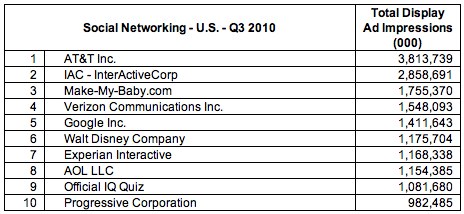 Facebook is feeling the sting of the ad scam. Matt Cutts is a software engineer at Google and head of the webspam team, and yesterday discovered that www.make-my-baby.com (please, for your sake, don’t follow that link) is spamming the hell out of Facebook users.
Facebook is feeling the sting of the ad scam. Matt Cutts is a software engineer at Google and head of the webspam team, and yesterday discovered that www.make-my-baby.com (please, for your sake, don’t follow that link) is spamming the hell out of Facebook users.
Advertising publication AdAge recently assessed Facebook’s monumental ad revenue growth, which has seen a 151-percent increase since 2009. The article also mentions that “the third-biggest advertiser was a completely unknown brand called Make-my-baby.com [which falls behind AT&T and Match.com] that bought $1.75 billion ad impressions in the third quarter.”
Make-my-baby is reportedly a Bing affiliate spam site that requires users to install a browser plugin. It switches your default search and home page to Bing before you can actually access the site. A spam-heavy toolbar will also be installed, and each time you unwittingly click on an ad, a company called Zugo will reap a portion of the profits. Zugo is a company that builds customized start pages that “allow you to extend your brand to your users’ online activies [sic].” It also includes in these customized pages the best “sponsored listings around the web.” Sure, nothing illegal is going on here — it’s really just Internet marketing using the tools at its disposal. Not to mention the fact that Make-my-baby and Bing are hardly the first properties to take advantage of users this way. But it’s still pretty sleazy.
Just to ease your curiosity, the Make-my-baby site is nothing more than an image of an infant that you can adorn with mustaches, glasses, hats, and other accessories. In other words, it is most definitely not worth surrendering your browser to — especially seeing as Cutts noticed the plugin’s uninstall instructions lead to a broken link.
Make-my-baby is probably wise to invest in Facebook advertising. Far too many users are overly willing to install applications that reap ridiculous amounts of personal information and glean user data for third-party vendors. A site that takes over your search engine with nothing more than an installed plugin seems right at home.
ReadWriteWeb received a comment from a Facebook spokesperson claiming Make-my-baby does not advertise at all with the site, and that anyone pushing its ads would be shut down. A Microsoft rep also stated the company would be terminating its relationship with “this publisher.” ReadWriteWeb also published the comScore chart AdWeb referenced when ranking Facebook’s top advertisers:



